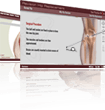Your Physical Therapy
A Physical Therapist works with you throughout your hospital stay. If possible, the therapist will see you prior to surgery to familiarize you with the exercise program. You should begin as soon as possible to tighten the muscles of your thigh (quadriceps) and your calf muscles (gastrocs). The therapist will see you the day after surgery to help with these exercises and help you to sit up on the side of the bed.
Your therapy program begins immediately following your surgery. The therapy program is designed to improve your hip strength and stability. Many patients find that gym clothes or shorts are more comfortable than pajamas for their exercise sessions.
The Occupational Therapist helps determine what special devices you may need at home to help you in your daily activities. This may include an elevated commode seat or shower bench.
You will be given the following set of exercises to do in bed:
- Deep breathe and cough
- Ankle pumps
- Tighten knees
- Tighten buttocks
Do each of these 10 times per hour.
You will be taught the dos and don’ts of hip replacement. You should follow these dos and don’ts for the next four weeks or until advised by your physician:
- DO NOT cross your legs, pivot or excessively roll your leg inward or outward, until instructed by your therapist or physician. This prevents dislocation.
- DO NOT flex your hip beyond 70 degrees. This means no bending, stooping, sitting in overstuffed chairs or low chairs. Your knees should be no higher than your hips. DO NOT lean forward while sitting in a chair.
- DO NOT take prolonged rides in cars. DO stop periodically to walk and stretch. DO NOT sit for long periods of time or become overly tired.
- DO NOT take chances, i.e., be careful on uneven ground, ice and snow. Avoid sports that put stress on your hip or knees such as golf, swimming, or brisk walks until approved by your physician.
- DO NOT drive a vehicle unless it has been discussed with your physician.
- WOMEN-FOR SIX MONTHS, DO NOT shave your legs from a standing position. If sitting, DO NOT roll your leg inward with the hip flexed to shave the back of the leg. Do everything between your knees, not outside your knees.
- TED stockings should be worn during the day for four weeks after leaving the hospital. If any unusual calf or thigh swelling occurs, notify your physician or your therapist.
- Gardening may be done with a stool and long handle equipment, if directed by your physician.
- Limit yourself to light housework with no bending or heavy lifting until directed by your physician.
- Take multivitamins with iron daily, eat a balanced diet, and get adequate rest. Take frequent short walks. Use an elevated toilet seat if indicated by your Therapist.
- Continue with the exercises as instructed by your Therapist.
- Caution your dentist or your urologist about any manipulation of teeth or urinary tract. You should have antibiotics 24 before and 72 hours after any tooth extraction or dilation of the urethra.
- Notify your airline before travelling that you have had a total hip or knee replacement, as you may set off the metal detection device in the securiiy check points at the airports. You may request an aisle or bulkhead seat to allow for more leg room.
- Ask questions if anything is unclear in your mind. Call your Therapist or Doctor.
- Keep pillows between the legs while lying on your side.
- Stop and stretch periodically during car rides.
| Back to Main Page |













